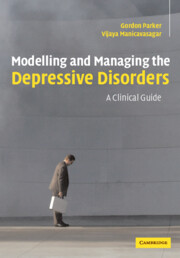Book contents
- Frontmatter
- Contents
- Acknowledgements
- Introduction
- Part I The current model for depressive disorders and its impact on clinical management
- Part II The diagnosis and management of melancholic and psychotic depression
- Part III An introduction to non-melancholic depression
- Part IV Modelling and managing the non-melancholic depressive disorders
- Appendix 1 The DMI-18 and the DMI-10
- Appendix 2 The CORE system of measuring psychomotor disturbance
- Appendix 3 The temperament and personality measure
- References
- Index
Appendix 1 - The DMI-18 and the DMI-10
Published online by Cambridge University Press: 17 August 2009
- Frontmatter
- Contents
- Acknowledgements
- Introduction
- Part I The current model for depressive disorders and its impact on clinical management
- Part II The diagnosis and management of melancholic and psychotic depression
- Part III An introduction to non-melancholic depression
- Part IV Modelling and managing the non-melancholic depressive disorders
- Appendix 1 The DMI-18 and the DMI-10
- Appendix 2 The CORE system of measuring psychomotor disturbance
- Appendix 3 The temperament and personality measure
- References
- Index
Summary
The 18-item Depression in the Medically Ill (DMI-18) and the briefer DMI-10 (Parker et al., 2001a, b), were originally developed as short-screening measures. Items are independent of medical illness features, as many (e.g. sleep disturbance, appetite disturbance, and weight change) overlap with physiological symptoms of depression. Thus, only ‘cognitive-based’ items reflecting the mood state of depression are included while somatic symptoms are excluded.
Items are scored on a 4-point scale, where a score of 0 indicates the statement is ‘not true’; 1, ‘slightly true’; 2, ‘moderately true’; and 3, ‘very true’. Individual item scores are summed to derive a total depression score. For the extended version, the DMI-18, a cut-off of 20 or more is indicative of probable or definite depression while, for the briefer DMI-10, a score of 9 or more is suggestive of probable or definite depression.
The measure has also been tested on a large sample of over 600 patients attending general practitioners, where its utility as a screening measure of state depression has been established (Parker et al., 2001c). Criterion-related validity was reflected in the high sensitivity (94–100% for the DMI-10 and 92–95% for the DMI-18) and specificity estimates (66–70% for the DMI-10 and 68–72% for the DMI-18) of the measure against two criteria: the clinical judgement of a psychiatrist, and the computer-generated Diagnostic and Statistical Manual of Mental Disorder (DSM-IV) diagnosis from the Composite International Diagnostic Interview (CIDI) (World Health Organization, 1997; Parker et al., 2001b).
- Type
- Chapter
- Information
- Modelling and Managing the Depressive DisordersA Clinical Guide, pp. 224 - 225Publisher: Cambridge University PressPrint publication year: 2005



